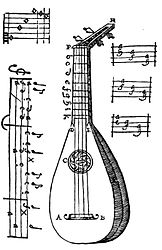Mandore (instrument)

Picture of a mandore, with François de Chancy's tablature from Marin Mersenne's Harmonie Universelle, published 1636 in Paris.
|
|
| Classification | |
|---|---|
| Related instruments | |
The mandore is a musical instrument, a small member of the lute family, teardrop shaped, with four, six courses of gut strings and pitched in the treble range. It was considered a new instrument in French music books from the 1580s, but is descended from and very similar to the gittern. It is considered ancestral to the modern mandolin. Other earlier instruments include the medieval European citole and the Greek and Byzantine pandura.
The history of modern mandolins, mandolas and guitars are all intertwined. The instruments shared common ancestor instruments. Some instruments became fashionable widely, and others locally. Experts argue as to the differences; because many of the instruments are so similar but not identical, classifying them has proven difficult.
Some experts consider the mandore a forerunner to the mandolino (also known as a Baroque mandolin), which in turn branched out into a family of mandolins that includes the Neapolitan mandolin, the Genoese mandolin, and the Cremonese mandolin. Others consider that the mandore and mandolino may have been contemporary, with different names being used in different countries; the mandolino in Italy, the mandore in France. It is also considered a forerunner or close relative of the 17th century mandola.
The instrument has also been called mandora or mandola in Italian,vandola in Spanish and mandörgen, or quinterne in German. Michael Praetorius used the names Mandürichen, Bandürichen, Mandoër, Mandurinichen, Mandüraen, and Pandurina.
While the mandore and mandora have been considered equivalent names for the same instrument by some authors, there are authors who believe that mandora is strictly for a different kind of lute, tuned in the bass range. For an article on the bass-range instruments, see Mandora.
The instrument has also been mistakenly called mandöraen instead of mandörgen by modern readers of Praetorius' book. However, the "raen" in the word is actually "rgen". The error is due to a lithographic fault in reproducing plate 16; that fault truncated the g into an a. The error can be seen when comparing two different versions of the plate (compare the two versions in the file history).
...
Wikipedia
